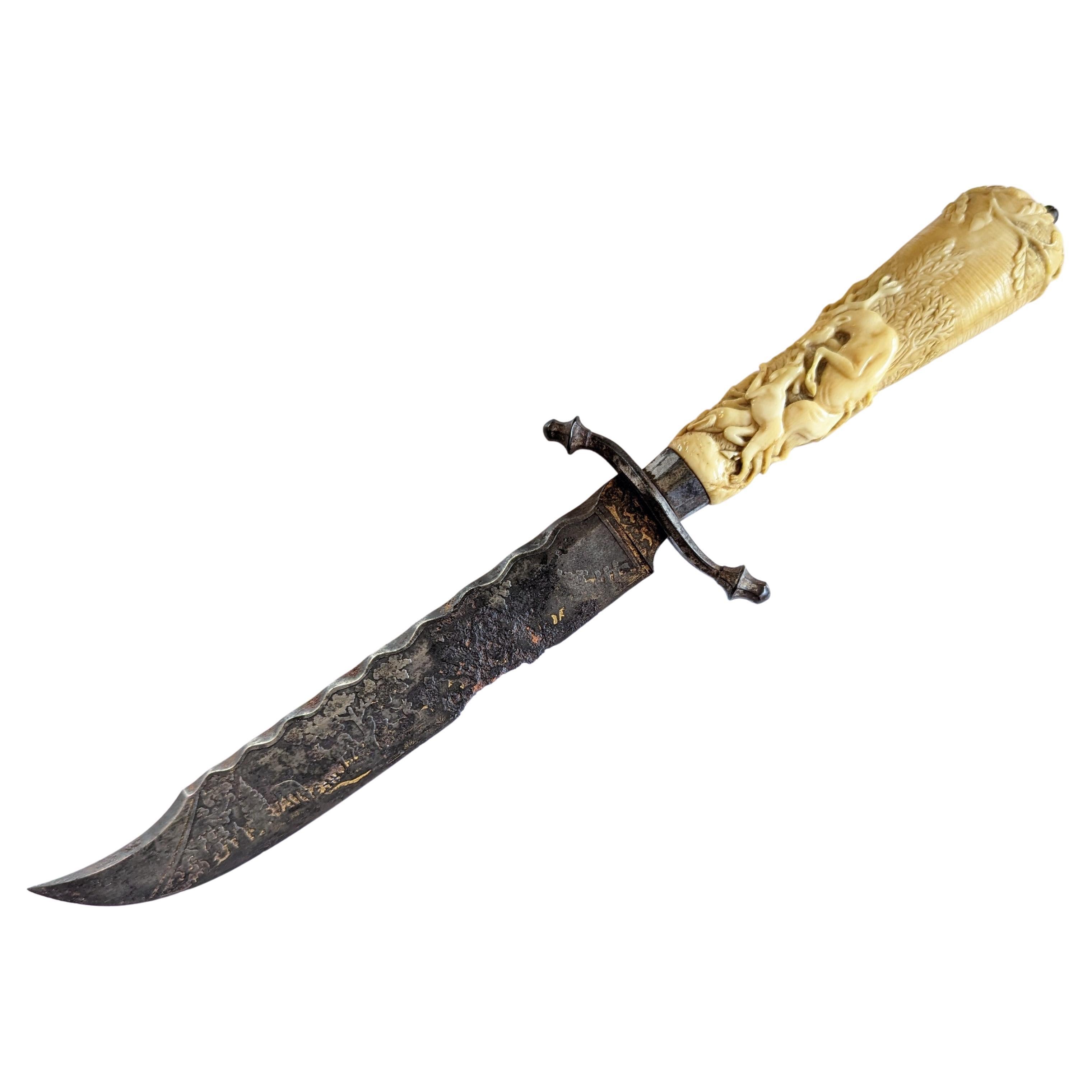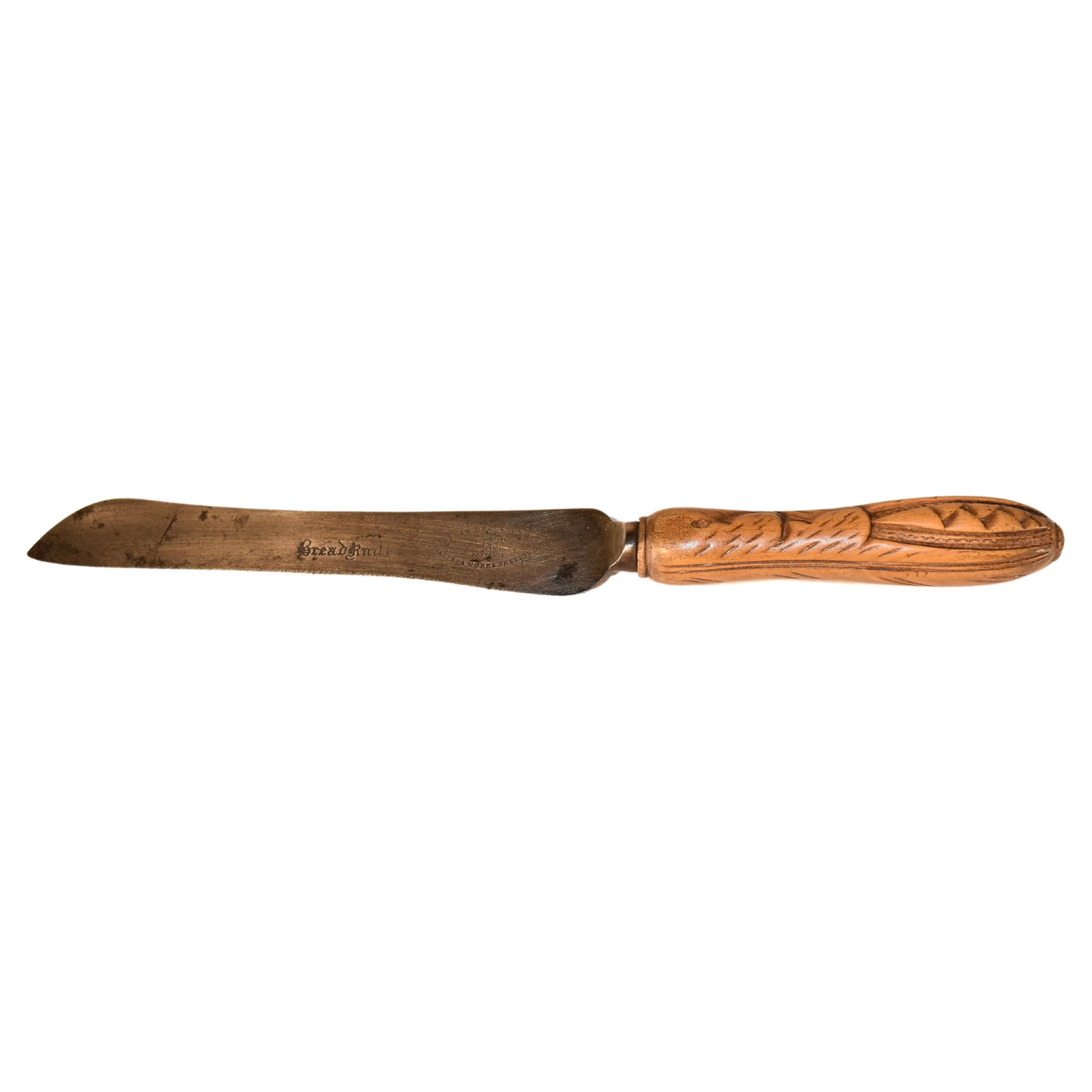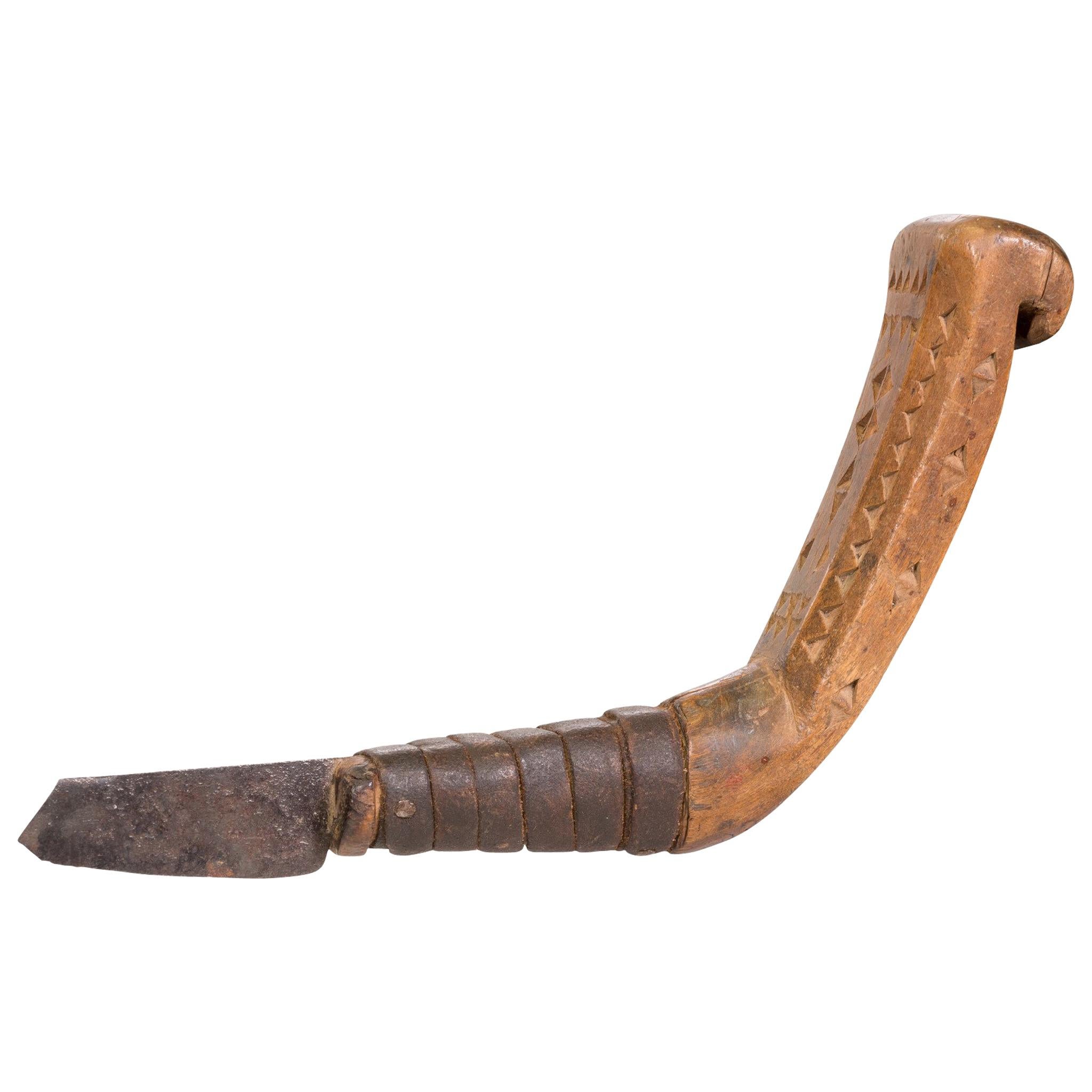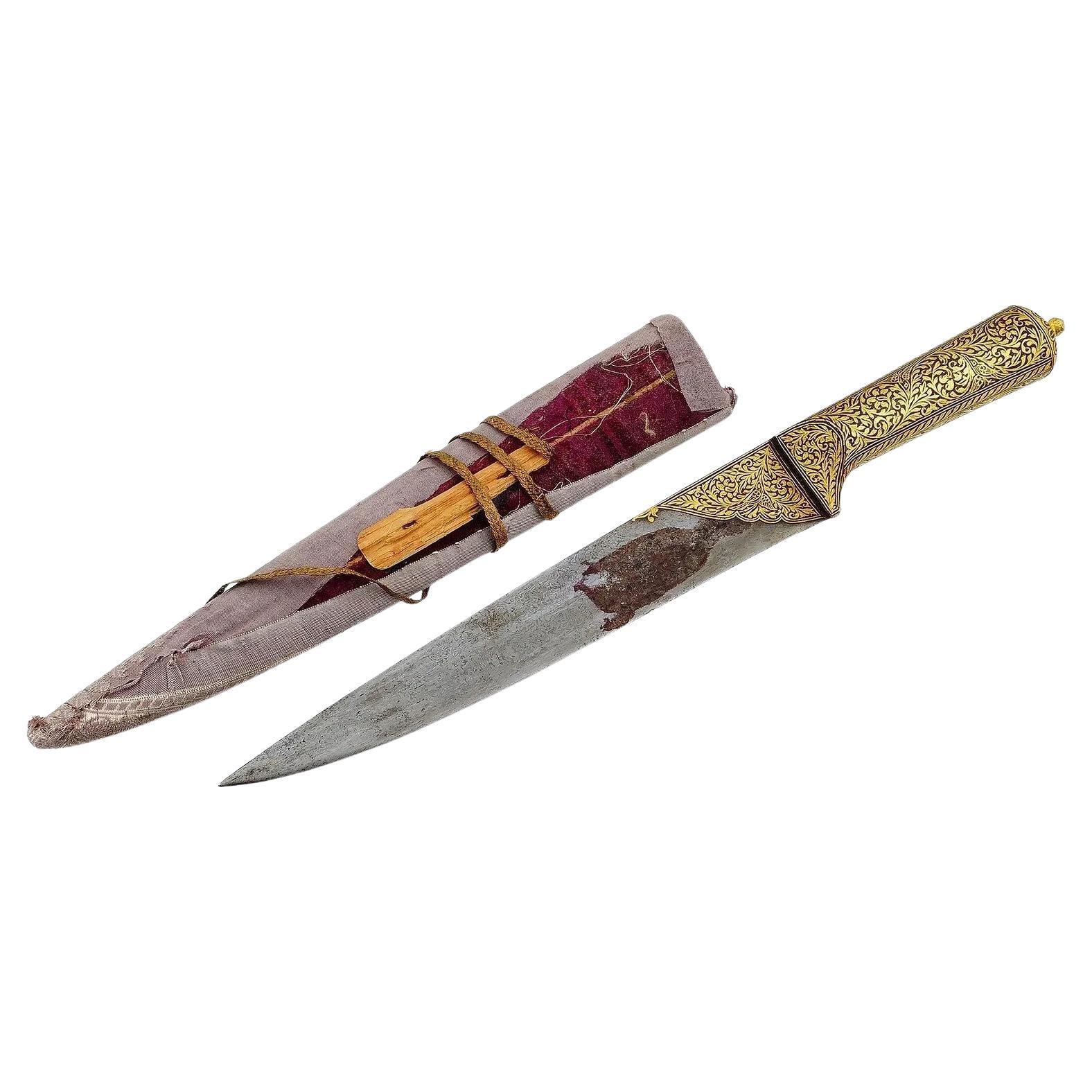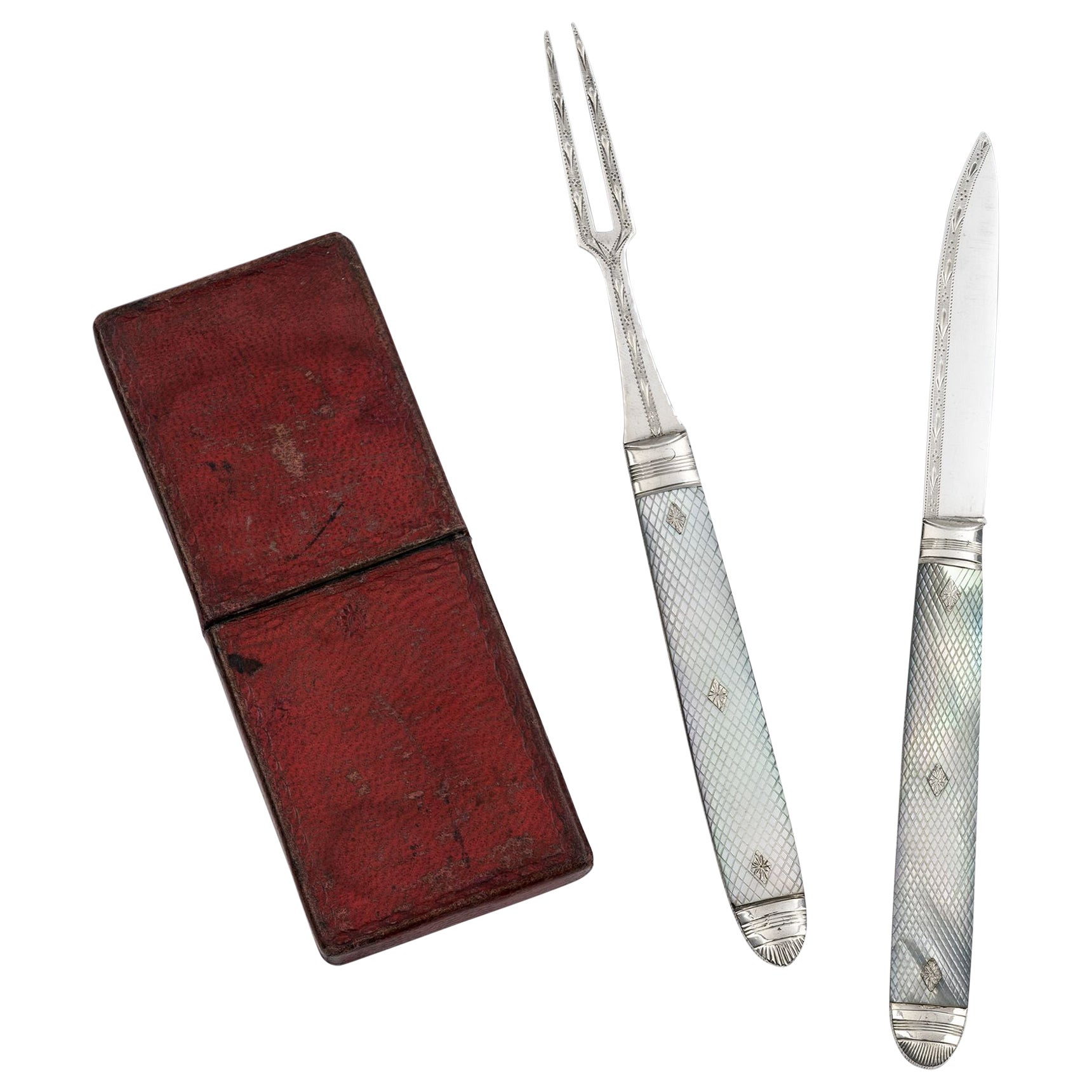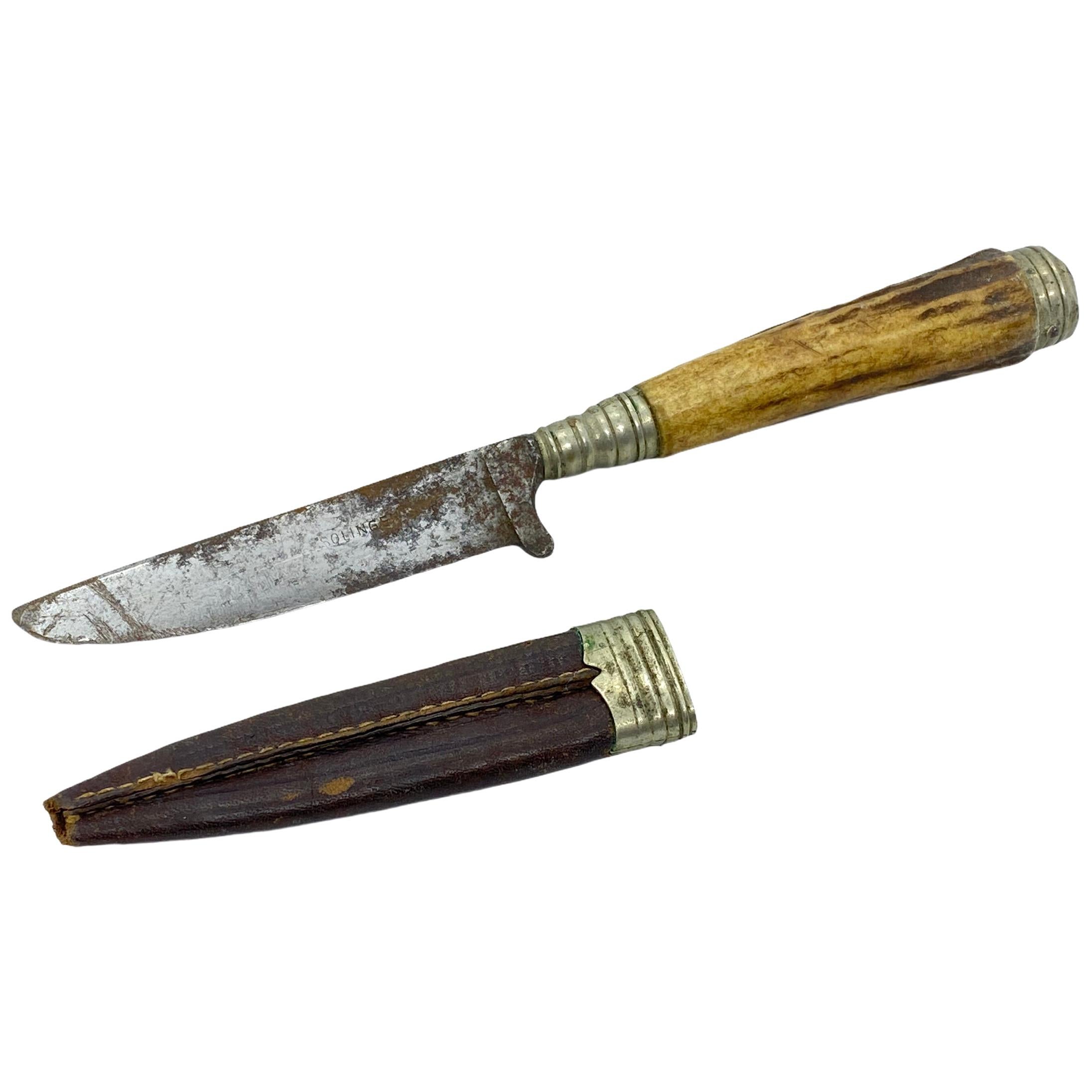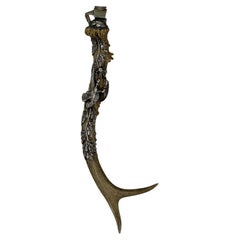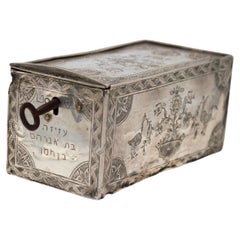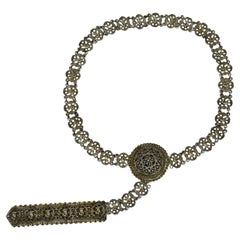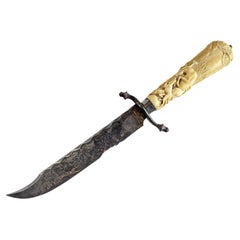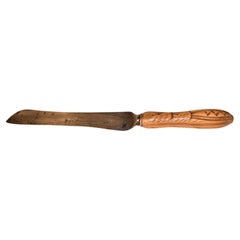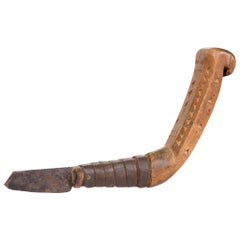Items Similar to Very Rare 17th century Italian Judaica wood silver Circumcision Knife
Want more images or videos?
Request additional images or videos from the seller
1 of 21
Very Rare 17th century Italian Judaica wood silver Circumcision Knife
$18,000
£13,742.92
€15,879.82
CA$25,268.59
A$28,164.48
CHF 14,776.94
MX$343,934.21
NOK 187,108.14
SEK 176,845.65
DKK 118,518.02
About the Item
Here we have this important and very rare example of early Judaica, made in Italy or south Germany, this Circumcision Knife is made from iron, has the guild mark on the blade as used to be on such early blades (usually forged in Germany) the handle is the important part, it is hand carved in fruitwood with an amazing depiction of the Binding of Isaac or Sacrifice of Isaac, on the scene you can see Abraham holding a bid knife or almost a sword, and next to him Issac is kneeling with his eyes covered, in front of them there is a cauldron with fire in it, and on the back, between the legs of Abraham you can see a small head of a Ram, he is almost unidentified but he is present in an almost theatrical whimsical way.
under the wood handle there is an octagonal silver strip that is connecting between the wood and the iron knife. the knife came to us from a distinct Judaica collection and it was stored in a tooled leather box, box has some "Fleur de lys" imprints in gilt on it, the box is not in a great state and it looks like its been to several restoration processes in the past.
a similar style of knife can be found in The Stieglitz Collection, that is now a part of the Israel museum permanent collection and in other collections around the world, Israel museum refers to this example as 17th century Italian.
- Dimensions:Height: 7.68 in (19.5 cm)Width: 0.79 in (2 cm)Depth: 0.6 in (1.5 cm)
- Materials and Techniques:
- Place of Origin:
- Period:
- Date of Manufacture:1600
- Condition:good condition, scratches, scoffs and some minor splits to the wood, no restorations to the knife and the wood handle box was restored in the past but in a stable condition, missing one hook.
- Seller Location:Tel Aviv - Jaffa, IL
- Reference Number:1stDibs: LU8130243376522
About the Seller
No Reviews Yet
Vetted Professional Seller
Every seller passes strict standards for authenticity and reliability
1stDibs seller since 2023
- ShippingRetrieving quote...Shipping from: Tel Aviv - Jaffa, Israel
- Return Policy
Authenticity Guarantee
In the unlikely event there’s an issue with an item’s authenticity, contact us within 1 year for a full refund. DetailsMoney-Back Guarantee
If your item is not as described, is damaged in transit, or does not arrive, contact us within 7 days for a full refund. Details24-Hour Cancellation
You have a 24-hour grace period in which to reconsider your purchase, with no questions asked.Vetted Professional Sellers
Our world-class sellers must adhere to strict standards for service and quality, maintaining the integrity of our listings.Price-Match Guarantee
If you find that a seller listed the same item for a lower price elsewhere, we’ll match it.Trusted Global Delivery
Our best-in-class carrier network provides specialized shipping options worldwide, including custom delivery.More From This Seller
View AllImportant Russian silver paper knife, Edward VII as a child, English royalty
Located in Tel Aviv - Jaffa, IL
Rare and extremely important Russian silver paper knife, it was probably made as a presentation gift to someone in the royal family, either the British or the Russian, the knife was ...
Category
Antique Late 19th Century Russian Victorian Letter Openers
Materials
Silver
Rare Antique Novelty German silver antler and silver cigar cutter, 1890-1900
Located in Tel Aviv - Jaffa, IL
Very attractive German silver mounted on an antler, cigar cutter
This cigar cutter is designed as oak leaves falling on the antler and in the middle There is a game bird of some kind hung from it, very realistic and well made.
This kind of objects were made in Germany and Austria so they can be given as High end gifts, used as a display piece with function in men clubs...
Category
Antique 1890s Sterling Silver
Materials
Silver, Steel
extremely rare Algerian Judaica silver, jewish Dowry box early 19th century
Located in Tel Aviv - Jaffa, IL
Amazing and scarce JUDAICA object, we have here one of the most touching jewish objects we had for a long time, this small silver dowry box was made in Algeria in the early 19th century, it is all covered with symbols of jewish faith and of couples, the sliding lid has 2 flanking birds with hamsa (protective hand) on each side and a flower vase in the middle.
one side shows two flanking lions with a tree in the middle and the other side shows again two big and two small birds with a flower bowl in the middle, front side has a key hole and next to it there is the Hebrew inscription ס״ט״" which says Siman tov or in English "a good sign" it is taken from the wedding blessing, underneath the lock there is another inscription with the name ״עזיזה בת אברהם בן חמו״ which is the name of the bride, her father and her grandfathers name.
the box is full marked a lot of times with the silversmith mark, every side of the box is marked.
this box was probably ordered by the grooms family to hold the jewelry they are giving to the bride as dowry, this type of objects are rare and there are just a few of them on museum collections.
DOWRY (Heb. נְדֻנְיָה), the property a wife brings to her husband at marriage; the Yiddish equivalent, nadn, is from the same root. The custom of nedunyah became clearly defined and institutionalized only in the talmudic period. In biblical times, mohar (מֹהַר), whereby the groom bought his wife from her father (Gen. 24:53; Ex. 22:15–16; Hos. 3:2), was the accepted practice. It was then customary that the groom give the bride gifts, and that she bring certain property to her husband's home upon marriage: slaves, cattle, real estate, etc. (cf. Gen. 24:59–61; 29; Judg. 1:14ff.; I Kings 9:16). Evidence of the custom of nedunyah is to be found in Tobit (7:14; 8:21) and in the Assuan papyri (Cowley, Aramaic, nos. 15, 18). Gradually, mohar was superseded by the ketubbah custom according to which the husband merely assumed the responsibility of compensation to his wife in case he divorced her: he had to pay her 200 zuzim if she had been a virgin at the time of marriage, and 100 zuzim if a widow or divorcée (see *Ketubbah).
By talmudic times, the institution of nedunyah was prevalent; the father gave a dowry to the bride since the daughter was excluded from paternal inheritance. Fifty zuzim (equivalent to the worth of 180 grams of silver) was the minimum amount a father was obliged to give to his daughter (Ket. 6:5). Parents usually gave much more, according to their social standing. Community funds provided the dowry for an orphan or a very poor girl (ibid.; cf. Sh. Ar., YD 251:8). In case of her father's death, the brothers of a minor girl were obliged to give her the minimum dowry, and the court estimated how much her father would have given her above the minimum dowry. The sum was then taken out of the father's estate and given to the daughter upon majority (Ket. 6:6; 68a–69b). In the absence of such an estimate, each daughter was entitled to receive one-tenth of the value of her father's estate in money, or in valuables (Yad, Ishut, 20:4–7; Sh. Ar., EH 113:4). If the father was unable or unwilling to pay the promised dowry at the betrothal ceremony, the groom could refuse to marry his bride (Ket. 13:5; Ket. 108b–109a). Insistence on exact payment of the promised dowry, however, was frowned upon by later rabbinic authorities (Rema to Sh. Ar., EH 2:1). In certain communities it was customary for the groom's father to make a dowry contribution equal to that of the bride's father (Ket. 102b). The dowry, whether given in real estate, slaves, money, or chattel was recorded in the marriage contract (the ketubbah) and in some instances one-third or one-fifth of the actual value of the dowry was added to the sum mentioned in the ketubbah. Based upon a decree enacted by *Simeon b. Shetah (first century C.E.), the Talmud ruled that the husband and his entire property were liable for compensation as stipulated in the ketubbah, either in case he died (when she collected the sum specified in the ketubbah from the heirs) or in case he divorced his wife (Ket. 82b). For the status of the dowry and the husband's rights and obligations, see below. The rabbinic enactments (Takkanot Shum) by R. Jacob *Tam and by the rabbinic synod of the communities of Speyer, Worms, and Mainz (Germany) stipulated that if a woman died...
Category
Antique Mid-19th Century Algerian Tribal Art
Materials
Silver
Important and rare jewish silver Sivlonot /wedding belt, Frankfurt 1707-1723
Located in Tel Aviv - Jaffa, IL
Important and rare Sivlonot belt, gilded silver, made by the famous silversmith Johann Mathias Sandrat active in 1707-1723 in Frankfurt, Germany. this JUDAICA object is a museum piece and An almost identical belt with a replaced buckle is exhibited in the Israel museum and came from the important Feuchtwanger Collection, purchased and donated by Baruch and Ruth Rappaport, Geneva.
the belt also bears 2 Christies auction stickers with the number 120, probably lot # 120, indicating it was sold in one of their auction rooms at some point.
Sivlonot (wedding) belt:
In Rabbinic literature, sivlonot refers to gifts the groom gave his wife-to-be. Among German Jews...
Category
Antique Early 18th Century German Sterling Silver
Materials
Gold Plate, Silver
Important 18th century Persian Jewish silver Amulet for mother and newborn
Located in Tel Aviv - Jaffa, IL
Mysterious Amazing, 18th century silver talismanic amulet, Amulet for mother and Newborn with image of Lilith in the center made by Jews in Persia, the top of the Amulet has an amazi...
Category
Antique 1790s Tribal Art
Materials
Agate, Silver
Early 20th Century Silver Spice Tower by Yehia Yemini, Bezalel School Jerusalem
Located in Tel Aviv - Jaffa, IL
Very rare Bezalel Jerusalem silver filigree spice tower, this amazing spice Tower was Made by Yehia Yemini, who was the best filigree artist in bezal...
Category
Vintage 1920s Israeli Sterling Silver
Materials
Silver
You May Also Like
Antique Hand Carved Bone Knife Hunting Scene Damascene Blade Possibly German
Located in Greer, SC
Exquisite antique hand carved bone knife with intricate hunting scene design. European made, possibly south German circa 1700s to 1800s, though we are not completely certain. The bla...
Category
Antique 19th Century European Other Knife Boxes
Materials
Bone
19th Century Hand-Carved Bread Knife
Located in High Point, NC
19th century bread knife from England. The handle is made from sycamore and is hand-carved with a design of wheat with a Sheffield signed blade. These are wonderful for serving or ...
Category
Antique 19th Century English Victorian Serving Pieces
Materials
Sycamore
Eastern Woodland Crooked Knife
Located in Coeur d'Alene, ID
Eastern woodland crooked knife. Solid handle having an exquisite hand chipped carved American Folk Art style geometric design. The blade is hand forged i...
Category
Antique Mid-19th Century American Native American Native American Objects
Materials
Wood
Antique Islamic Persian Damask Steel Kard Knife W Scabbard
Located in Long Island City, NY
An antique Persian damask steel Kard knife with a scabbard. The blade is made of damask steel, flat, single edged, without fullers, the combat end is double edged. The handle and part of the blade are richly decorated with gold tone foliate patterns. In the middle of the blade, there is a diamond shaped overlay with gold tone calligraphy. The sheath is covered with fabric. Kard is considered a type of knife found in the Persianate societies like Persia, Turkey, Armenia, and all the way to India. Mostly used in the 18th century and before, it has a straight single edged blade and is usually no longer than 41 centimeters, 16 in, in length. A major characteristic of a kard is that the hilt is partially covered by the sheath. Antique Military Collectibles...
Category
Antique 18th Century Unknown Arms, Armor and Weapons
Materials
Steel
George III Folding Fruit Knife and Folk, circa 1786-90
Located in London, GB
A very unusual cased George III folding fruit knife and folk made most probably in Sheffield circa 1786-90
The Fruit Knife and Fork is of an unusu...
Category
Antique 18th Century English George III Tableware
Materials
Silver, Sterling Silver
Antler Handle Fixed Blade Knife with Leather Sheath Antique German Folk Art
Located in Nuernberg, DE
A antique Knife from Solingen, Germany. Deer antler or stag handle with original sheath 3.13" blade, 6.75" Overall. Used in good condition with some sharpe...
Category
Early 20th Century Austrian Folk Art Taxidermy
Materials
Metal
More Ways To Browse
Italian Wood Carving
European Wood Carvings
Antique Italian Wood Carvings
Wood Sword
Antique Knife Boxes
Sword Leg
Antique Judaica
Antique Welding
Rams Head Carved Furniture
Hand Forged Iron Handles
Wood Kneelers
Antique Carving Tools
Rare Antique Knife
Antique Judaica Silver
Hand Carved Israel
17th Century German Silver
17th Century German Silver
Carved Wood Ram
